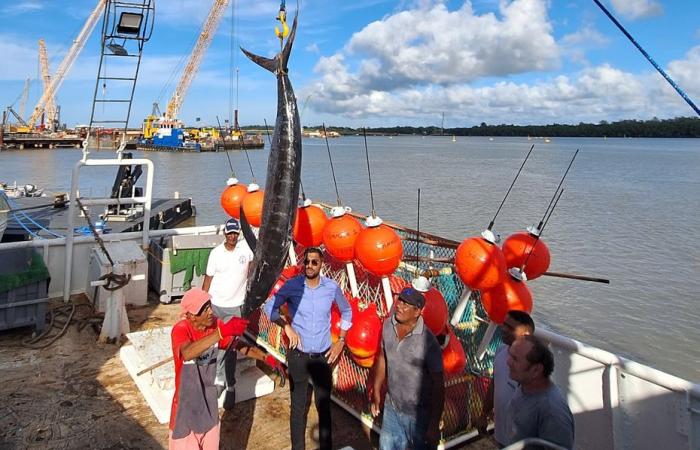After a five-day exploratory campaign, the Antoine Abchée et fils Company ship arrived this Wednesday morning at the port of Larivot with tuna, swordfish and sea bream in its holds. Two other sorties are planned but the mission is already considered a success. It could lead us to be able to consume and export these deep-sea fish caught in Guyanese waters.
There are only ten fish in the hold but when the Yannick 2 docks at the port of Larivot, everyone's faces are satisfied. For the Antoine Abchée et fils Company (Saf), at the origin of the mission, the fishing is definitely good. « From now on, we can affirm that in Guyana there are large pelagics » announces Ryan Persaud, director of the Saf, while the crew gets off the boat, yellowfin tuna, swordfish, dolphinfish, blue marlin, barracuda…
All were fished between 180 and 200 kilometers from our coasts. The area is authorized for fishing… but not for these fish which are subject to quota. Also, for this mission, exceptional sampling authorization was requested by the Antoine Abchée et fils Company.
•
©AV
Several objectives motivated this mission at a total cost of 800 000 euros : diversification of resources, conquest of new commercial niches, food sovereignty…Ryan Persaud adds another aspect : “resource preservation”. More respectful of the species, line fishing, unlike net fishing, makes it possible to limit accidental captures. Before setting sail, the Yannick 2, a 32-year-old former trawler, had to undergo some modifications to transform into a longliner. Removed from its net used for shrimp fishing, the boat was equipped with a 50 kilometer long fishing line equipped with a thousand hooks. « We also used circle hooks, specifies Pascal Briand, the fishing captain. With this type of hook, if we happen to catch a species that is not the one we are looking for, fish or turtle, we can unhook the animal and put it back in the water. The round hook allows survival which is estimated at 95% »
•
©AV
Two other missions at sea are planned for this campaign during the month. Each time, an observer will be included in the crew. Nicolas Moulanier, fisheries explorer for the Fhishing cleaners design office was on the first outing, where he took measurements and collected data. Its report distributed to various stakeholders in the maritime world. “ What we got is satisfactory, but everything remains to be done. We need to increase the number of replicates to translate data efficiently and identify areas most prone to accidental capture in order to avoid it. »
•
©AV
After the next two missions, the Antoine Abchée et fils Company will move on to the next step: request authorizations to allow Guyana to integrate the harvest quotas for these fish. An essential step to enable their marketing and transformation.
Until then, and as it is not possible to sell the fishing carried out during these exploratory missions, it is above all Saf employees who will benefit. A first tasting will be offered to crew members and financial partners who will be able to discover the taste of yellowfin tuna from Guyana on their plate.
•
©AV






